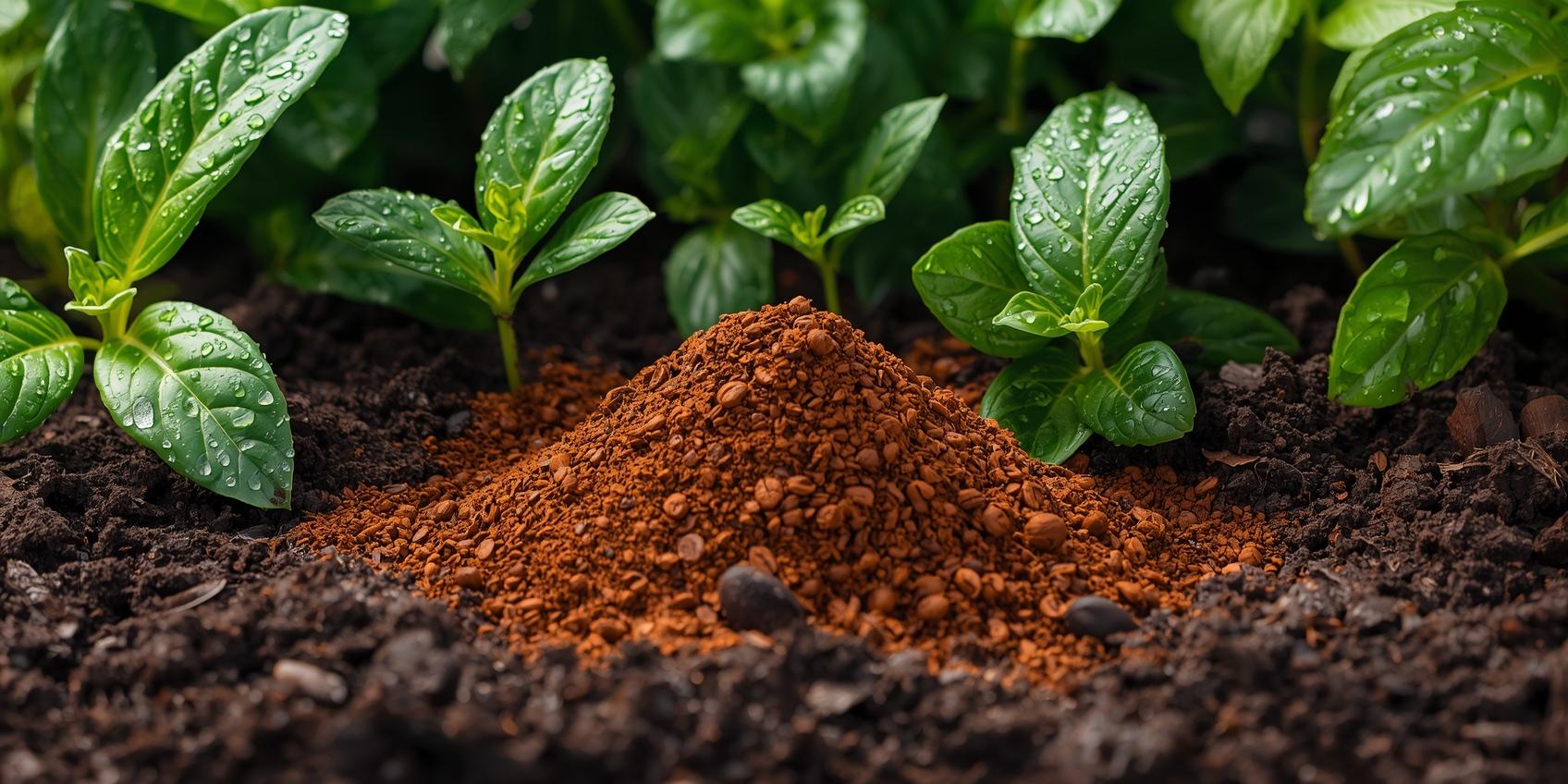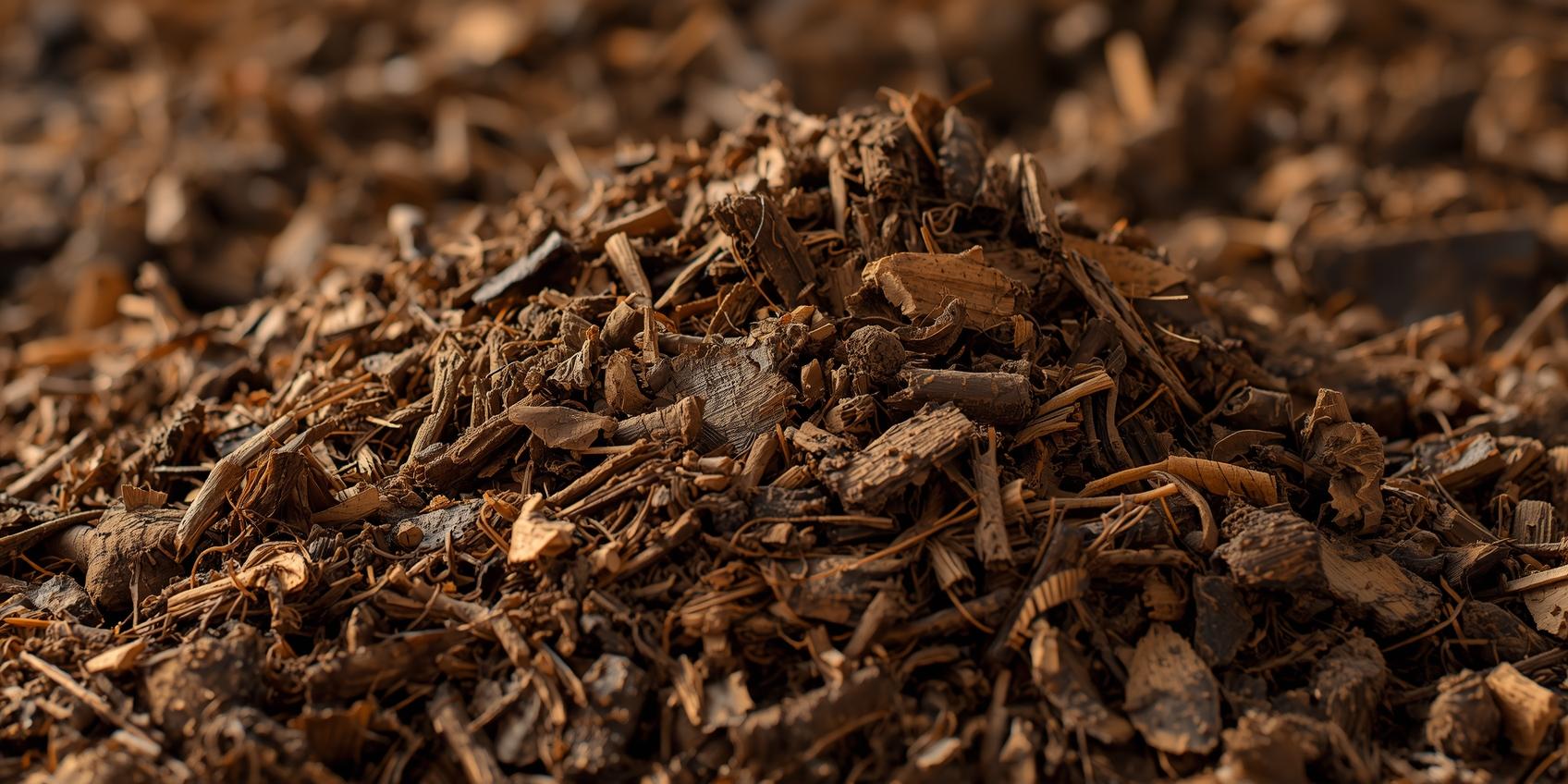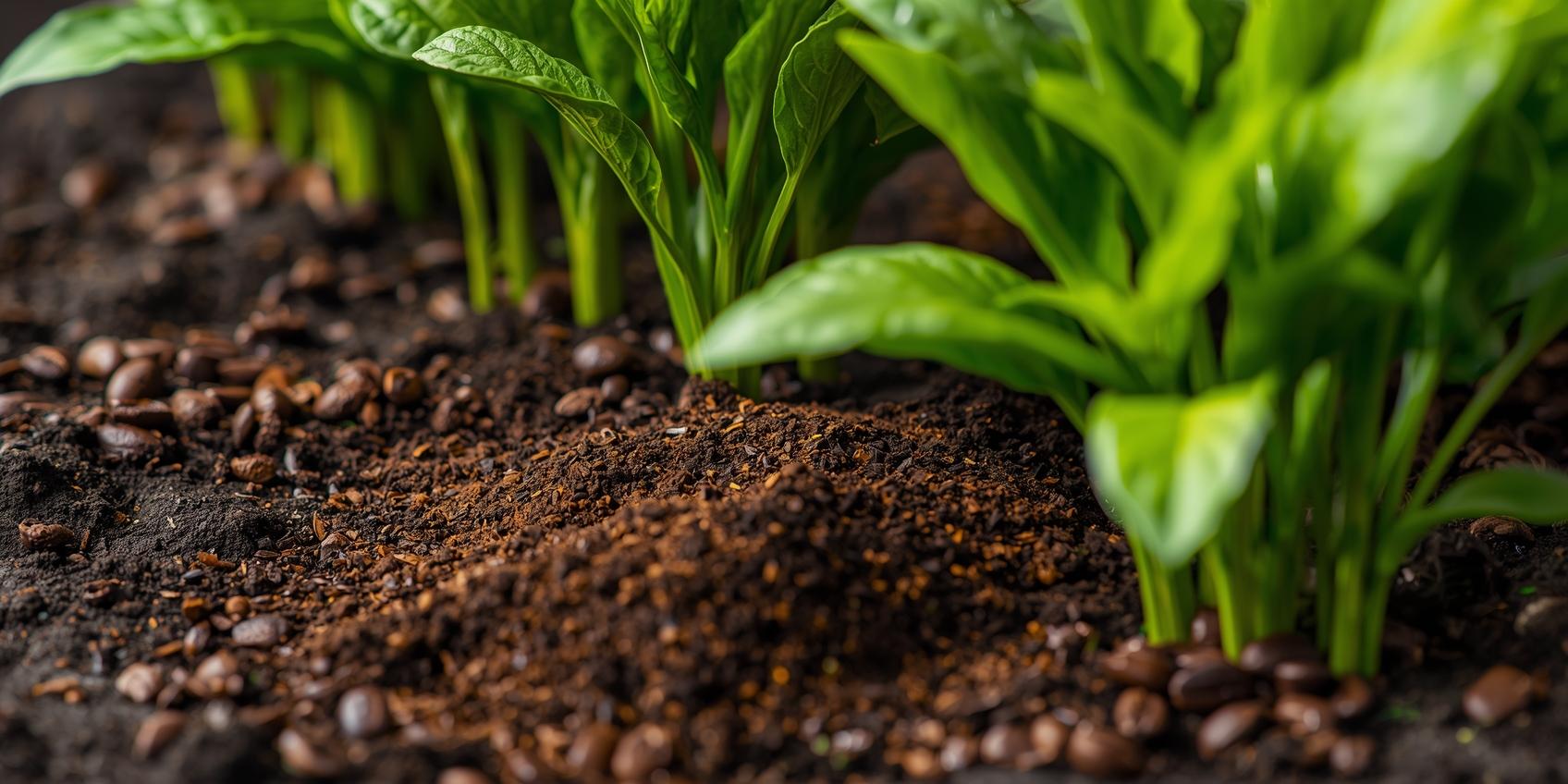(Compost, Composting, Vermicomposting, and Compost Tumblers Explained)
Explore The Benefits of Coffee Grounds to a Garden plus composting tips. Discover how coffee grounds boost compost, vermicomposting, and compost tumbler results.
Coffee grounds bring a surprising burst of life to your garden.
If you’re curious about compost, composting, vermicomposting, and how a compost tumbler works, you’re in the right place.
Composting turns everyday scraps like coffee grounds into nutrient-rich soil, a bit like nature’s recycling plant right in your own backyard.
It’s a simple, hands-on way to reduce waste, help plants thrive, and live a little greener.
So, what is composting and why does it matter?
Composting is the natural process of breaking down kitchen and garden waste into valuable compost. Anyone can do it at home, and it’s much easier than it sounds.
Old coffee grounds, peelings, and veggie bits join up in a bin, pile, or tumbler where worms, bugs, and microbes turn them into a crumbly mix that feeds your plants.
It’s like baking a cake for your garden, and the main ingredient could already be sitting in your coffee filter.
In this post, you’ll learn why coffee grounds are prized for compost and garden beds.
You’ll see how they can boost plant health, help your soil, and make composting easier for beginners.
We’ll also share practical tips for getting started with home composting, vermicomposting, and using a compost tumbler.
Using coffee grounds is a habit that fits naturally with any home composting routine—easy, rewarding, and excellent for the environment.
Key takeaways from this article:
- Coffee grounds offer big benefits to gardens and compost bins.
- Composting is an easy way to recycle kitchen waste and improve plant health.
- Beginners can start composting with simple methods and a few basic tools.
- Coffee grounds work well in traditional compost, vermicomposting, and compost tumblers.
- Sustainable gardening can be fun, practical, and good for your whole family.
Compost Basics and Why Coffee Grounds Shine
Composting brings real excitement to even the most ordinary kitchen scraps, and coffee grounds have a starring role in the process.
When you begin adding coffee grounds to your compost bin, you’re introducing a powerhouse ingredient that both nourishes your soil and speeds up the whole composting routine.
Coffee grounds fit neatly into many composting setups, from backyard piles to compact compost tumblers.
Here’s why they belong in your garden toolkit.
What Is Compost Made Of?
At its core, compost is a blend of “green” and “brown” materials. Greens are rich in nitrogen (like food scraps and grass clippings), while browns bring the carbon (think dried leaves and paper).
This balance is key for successful composting and happy, healthy soil.
Some popular green and brown choices:
- Green materials: coffee grounds, vegetable peelings, tea bags, fresh grass
- Brown materials: dry leaves, shredded cardboard, straw, small wood chips
Coffee grounds are considered a “green” despite their color. This means they’re packed with nitrogen, just like fresh grass.
When you add them to your pile or compost tumbler, you boost the microbial activity that transforms waste into dark, crumbly compost.
Why Do Coffee Grounds Stand Out?
Coffee grounds have several garden superpowers. First, they feed the hungry microbes, worms, and even bugs working hard in your compost pile.
As the grounds break down, they release:
- Nitrogen: vital for plant growth
- Potassium and phosphorus: for strong roots and happy blooms
- Extra micronutrients: such as copper, magnesium, and calcium
The real magic, though, is how coffee grounds help your entire composting process.
They heat up the pile (especially useful in chillier months), attract earthworms that munch and aerate, and even improve texture so compost is fluffy rather than soggy.
Curious about which composting method works best with coffee grounds?
Dive into 6 effective composting methods to discover which style suits your household.
Composting, Vermicomposting, and Tumblers: Coffee Fits Right In
Whether you’re using an open bin, a handy compost tumbler, or a worm-rich vermicomposting system, coffee grounds change the game. Here’s how:
- Compost piles and bins: Mix in coffee grounds for quick heating and balanced nutrition.
- Compost tumblers: The grounds help maintain moisture and speed up decomposition, so your tumbler produces finished compost faster.
- Vermicomposting: Worms love coffee grounds (just not too much at once), and the gritty texture helps them digest other scraps.
Too many fresh grounds at once can clump together, so sprinkle or mix well into other materials for best results.
Coffee Grounds and Soil Enrichment
Adding coffee grounds to compost does more than just recycle waste.
As they decompose, coffee grounds boost soil structure—think airier beds, better drainage, and soil that’s easier for roots to wiggle through.
They also help soil hold water, perfect for thirsty flowers and vegetables.
If you need a quick snapshot of what coffee grounds add to your compost, check out this simple table:
| Benefit | What Coffee Grounds Contribute |
|---|---|
| Nitrogen | Speeds decomposition, feeds plants |
| Texture | Aerates soil, prevents compaction |
| Micronutrients | Adds magnesium, calcium, copper |
| Moisture control | Helps soil hold water |
Want more science-backed details about using coffee grounds in your garden?
The team at Garden Design breaks it down.
Key Takeaways
- Coffee grounds supercharge compost with nitrogen and micronutrients.
- They improve soil texture and water retention when added to bins or tumblers.
- Grounds work in all systems: open piles, tumblers, even vermicomposting.
- Proper mixing is essential so they break down evenly without clumping.
If the details have your head spinning, check out the easy composting guide for approachable, step-by-step instructions.
Anyone can jump in and see the benefits of coffee grounds to a garden!
How Coffee Grounds Benefit Your Garden Soil and Plants
 Photo by Alexey Demidov
Photo by Alexey Demidov
Understanding the benefits of coffee grounds to a garden will change how you look at your morning cup.
Coffee grounds bring both big and small improvements to the soil and plants you care for.
Home gardeners can use this kitchen scrap in compost, vermicomposting, and a compost tumbler for a healthy, thriving garden with less waste.
Nutrient Boost for Soil
Coffee grounds are like a multi-vitamin for garden soil. They are a “green” material full of nitrogen, which supports leafy growth and stronger plant stems.
Besides nitrogen, they carry potassium, phosphorus, and trace micronutrients like calcium and magnesium.
As the grounds break down, these nutrients feed beneficial microbes and earthworms in the soil.
This whole process helps build a “living” soil for your garden.
- Nitrogen-rich: Powers new plant growth.
- Potassium and phosphorus: Encourage root and flower health.
- Micronutrients: Add subtle improvements to your soil’s ecosystem.
For more ways to use and balance compost ingredients (like mixing coffee grounds with carbon-rich leaves or straw), check out these tips on using compost additives for even richer results.
Improved Soil Structure and Drainage
Have sticky, compacted soil that plants struggle to grow in? Coffee grounds act like tiny natural aerators.
Their gritty texture loosens the soil, improves air flow, and stops water from pooling or running off too quickly.
Roots find it easier to grow, and water is held where plants need it most—not wasted.
This makes grounds perfect for reviving tired flowerbeds, vegetable plots, or even houseplant pots.
- Looser soil: Easier for roots to spread.
- Better water retention: Plants get “just right” moisture, not too wet or dry.
- Improved drainage: Prevents root rot and soggy patches.
Adding coffee grounds to your compost pile also boosts the decomposition process, making finished compost faster in your bin, pile, or compost tumbler.

Natural Mulch and Pest Helper
Coffee grounds aren’t just for feeding plants—they help protect them, too. When used as mulch, coffee grounds block weeds and keep the soil cool and moist.
Their gritty feel also bothers some garden pests like slugs and snails, though more is needed after rain since coffee breaks down easily outdoors.
- Weed control: Mulch helps crowd out unwanted sprouts.
- Moisture lock: Grounds help hold in soil moisture on hot days.
- Mild pest deterrent: Some pests avoid the texture and smell.
To prevent grounds from forming a water-blocking crust, always mix them with leaves, straw, or wood chips. Never pile them on too thick by themselves.
Compatibility With Different Plants
Are coffee grounds safe for every plant?
Most, but not all. Used (brewed) coffee grounds are nearly pH-neutral and work well for many garden favorites, especially:
- Acid-loving plants: Blueberries, azaleas, hydrangeas, and roses are classic fans.
- Vegetables: Carrots, radishes, potatoes, and peppers can enjoy looser, richer soil from coffee additions.
Avoid giving coffee grounds to plants that prefer sandy or alkaline soil, such as lavender or succulents.
For even more garden-specific advice, you might enjoy reading about the best compost for growing peppers, which includes tips for using grounds wisely.
Key Benefits at a Glance
Here’s how coffee grounds stack up as a garden helper:
| Benefit | Garden Impact |
|---|---|
| Nitrogen source | Stronger growth and greener leaves |
| Improved structure | Fluffier soil and quick root growth |
| Moisture management | Soil stays damp, less wilting in summer |
| Weed and pest barrier | Grounds help keep weeds and some pests at bay |
| Supports good microbes | Boosts soil health and disease resistance |
Smart Practices and Precautions
Use coffee grounds in moderation and always mix them into existing compost or soil.
The best results come from adding grounds little by little—no more than 20% of the total mix. Piling them too thick can cause clumping or block air and water.
It’s safe to add coffee grounds to most composting systems, including vermicomposting bins, but always keep an eye on the balance of “greens” and “browns.”
More tips are on composting coffee pods and grounds, which break down how best to use them in every garden setup.
Plants not fond of acidic conditions or very dry-loving plants (like succulents and lavender) should avoid frequent coffee ground applications.
Always watch pets, too, since coffee grounds in large amounts are not safe for dogs.
For deeper reading (and lots of science-backed wisdom), this article from Garden Design covers even more ways to use coffee grounds in the garden.
Key Takeaways:
- Coffee grounds offer a gentle, steady source of nutrition for most garden plants.
- Their gritty texture improves drainage, aeration, and helps balance moisture in soil.
- When mixed with other materials, coffee grounds deter weeds and some pests.
- Always use coffee grounds with care and balance for the healthiest garden.
- They work well in all composting methods, including traditional piles, vermicomposting, and compost tumblers.
For more details on improving your local soil with compost and coffee grounds, see the guide on composting’s soil benefits.
For more in-depth guidance and troubleshooting, don’t forget you can always visit the Compost Charm FAQ bot for friendly composting advice!
Practical Tips: Composting Coffee Grounds Safely
Using coffee grounds in compost gives your garden a real boost, but like any good thing, it works best with a bit of balance.
Sometimes, problems crop up—mats of slimy grounds, mysterious smells, or compost that just won’t break down. These headaches are easy to fix once you know what to look for.
Here’s how to keep your composting journey smooth, simple, and safe while adding coffee leftovers.
Troubleshooting Common Coffee Ground Compost Problems
Coffee grounds have huge benefits for your compost and your soil, but too much of a good thing can bring on a few classic troubles.
Let’s sort those out with practical fixes and prevention tips.
Matting and Clumping
Coffee grounds can stick together, forming dense mats.
These slick layers block air and trap moisture, sometimes leaving your pile soggy and smelly.
- Quick fix: Always mix coffee grounds with plenty of dry browns like shredded leaves, straw, or cardboard. Spread them in thin layers between these materials to stop mats from forming.
- Extra tip: If you notice mats in your bin or compost tumbler, give everything a good stir with a garden fork to break them up and let air in.
- Resource: Discover layering methods for effective composting for even better mixing at this layering guide.
Over-Acidity
Worried you’ll make your compost too acidic?
Used coffee grounds aren’t very acidic, but piling on too many at once can lower your pH and slow down helpful microbes.
- Quick fix: Keep coffee grounds at 20% or less of your total compost mix. Add extra browns (like leaves or paper) to bring things back to neutral.
- Science fact: Most used grounds come close to pH neutral, but fresh grounds can be more acidic. Letting used grounds dry out before adding them to compost helps too.
- Learn more: See A Common-Sense Guide to Using Coffee Grounds for the real story on acidity.
Unpleasant Smells
A well-balanced compost pile should never stink. If yours does, something may be off.
- Quick fix: Add more dry, brown materials. Stir often to bring in fresh air. Avoid dumping big batches of wet coffee grounds all at once.
- Bonus: Watch for wet, tightly packed areas that need fluffing. Compost needs air to break down scraps without bad odors.
- For stubborn smells: Grab quick fixes from this compost troubleshooting guide.
Slow Decomposition
Coffee grounds are greens, which should help speed things up.
But too much coffee, especially if mats form, can actually stall your progress.
- Quick fix: Turn your pile or tumbler every week to keep things moving. Mix coffee grounds with other greens for a winning combo.
- Troubleshooting help: For slow piles, you can also see how to troubleshoot slow compost in a tumbler with these tumbler tips.
Safe Limits and Alternate Uses
Here’s an easy rule: coffee grounds should never be more than one-fifth of your compost.
This is enough for microbe meals, but not so much that you risk a clumpy, sour-smelling bin.
If composting isn’t practical, don’t toss those grounds in the garbage! Try:
- Sprinkling grounds in outdoor garden beds as a light mulch (mix well to prevent a crust).
- Adding to worm bins in small amounts for happy, active worms.
- Deodorizing containers or scrubbing pots clean.
Need Custom Help?
If your situation feels extra tricky, or you just want more ideas about coffee ground recycling, swing by the friendly Compost Charm FAQ bot. It’s perfect for quick, personalized advice.
Key Takeaways
- Always mix coffee grounds with dry materials to avoid mats and bad smells.
- Don’t use more than 20% coffee grounds in your total compost pile.
- If your compost tumbler or bin gets slow, add more browns and turn the pile for faster results.
- Coffee grounds are safe and easy—just treat them like any rich ingredient in a recipe.
- If composting isn’t an option, use grounds for odor control or garden mulch.
- For step-by-step directions on composting methods and balancing your pile, check out the guide on layering methods for effective composting.
Coffee grounds make composting more rewarding, but it’s the little adjustments that keep your pile healthy and smell-free.
Remember, whether you use a simple bin, a sleek compost tumbler, or even vermicomposting, these tweaks unlock all the benefits of coffee grounds to a garden!
Summary: Key Takeaways and Simple Steps Forward
Understanding the benefits of coffee grounds to a garden means knowing you’re making a real difference each time you compost that morning brew.
With just a few small changes, anyone can boost their soil, help plants, and reduce waste in a simple, hands-on way.
Main Points to Remember
It’s easy to feel overwhelmed by new routines, but the heart of composting with coffee grounds is simple and friendly. Here’s what sticks:
- Coffee grounds bring garden gains. From nitrogen for lush growth to a boost in helpful microbes, used grounds pack your compost with nutrients plants love.
- It suits any method. Whether you prefer a compost bin, a whirl-it-around compost tumbler, or even vermicomposting with worms, coffee grounds break down well and keep the pile balanced.
- Good for soil and sustainability. The gritty grounds help loosen heavy soil, improve water holding, and support a sustainable cycle—right from your cup to the carrot patch.
- Less waste, more life. Every scoop of coffee in the compost means less in the landfill and more in your flowerbeds or veggie plot.
Quick Start Tips for Composting with Coffee Grounds
Ready to put all this into action?
Follow these easy steps and you’ll see healthy changes indoors and out:
- Collect used (brewed) coffee grounds. Let them dry before adding to your pile or worm bin to keep everything fresh and crumbly.
- Mix in, don’t mound. Sprinkle grounds through your compost or soil rather than dumping in thick layers. This prevents mats and helps everything break down.
- Team them with “browns.” Every handful of coffee grounds should meet a few handfuls of dry leaves, shredded paper, or straw. This keeps your compost’s balance just right.
- Try different systems. Add grounds to any compost setup—bin, tumbler, or vermicomposting box. If you’re not sure which system fits your space, explore different options in this composting apples guidance, which shows ways to balance coffee grounds with fruit scraps.
- Watch for results. With regular turning and good mixing, you’ll have finished compost in months, not years.
Everyday Applications for Gardeners
Coffee grounds aren’t only for compost piles. Use them to:
- Mulch garden beds (mix with other mulch for best results)
- Sprinkle lightly around slug-prone plants
- Add directly to planting holes for root veggies
- Enrich potting mix for indoor greens
For gardeners who love variety, discover even more uses—some unexpected—in this guide to unusual compostable items to include.
Trusted Knowledge from Experts
Still wondering if you’re getting it right?
Experts agree: coffee grounds are a solid choice for composting, and garden tests back up their reputation. You’ll find more scientific notes and user stories in Garden Design’s guide to using coffee grounds for plants.
Take confidence in each step—you’re building healthy soil, one cup at a time!
Key Takeaways
Looking for a cheat sheet? Here’s what anyone can do to enjoy the benefits of coffee grounds in a garden:
- Coffee grounds fit every compost method—regular bin, compost tumbler, or vermicomposting.
- Keep compost healthy by mixing grounds with lots of “brown” material.
- Only use coffee grounds for about 20% of your mix.
- They help soil hold water, add nutrients, and support garden life.
- Using them is a win for your plants and the planet.
Keeping things simple and steady means you’ll get lush gardens, healthy soil, and fewer trips to the landfill. Every sprinkle counts.

For more surprising ideas, head over to the collection of surprising composting options you can try at home.
If you’re curious about the science or want troubleshooting help, check expert answers and advice at How to Use Coffee Grounds for Plants.
Frequently Asked Questions About Using Coffee Grounds in the Garden
Curious about the details of composting coffee grounds, vermicomposting, or how coffee aids your compost tumbler?
These common questions shed light on practical topics and clear up confusion for beginners and experienced gardeners alike.
Let’s get right into the most-asked topics about the benefits of coffee grounds to a garden.
Can You Put Coffee Grounds Directly in the Garden?
Yes, but it’s best with a little mixing. Used coffee grounds are almost pH neutral, so most plants are safe.
Sprinkle coffee grounds around plants as a light mulch, but avoid thick layers that can clump and block water.
For easy use, blend them with leaves or straw so the soil breathes well.
If you’d like a step-by-step guide, read about seasonal composting calendar tips that include when and how to add kitchen scraps like coffee grounds throughout the year.
Do Coffee Grounds Make Soil Too Acidic?
This is a common concern, but most used (brewed) coffee grounds are only mildly acidic and quickly move toward neutral as they break down.
Composting grounds dilutes any acid, making them safe for nearly all garden uses.
- Key tip: Avoid piling grounds on acid-sensitive plants like lavender or sage.
- Best practice: Combine with “brown” materials (leaves, cardboard) in your compost bin for a healthy balance. For a scientific take on soil pH, see How to Use Coffee Grounds for Plants.
Are Coffee Grounds Good for Compost and Vermicomposting?
Absolutely. Coffee grounds are considered “green” material, so they speed up compost by feeding bacteria and worms.
In compost tumblers, grounds add nitrogen, helping heat your pile and break down other scraps.
Worms love coffee grounds, but don’t overload your vermicomposting bin. Add in moderation, and always keep enough dry bedding like cardboard to balance things out.
How Much Coffee Grounds Should I Use in My Compost or Compost Tumbler?
Keep them to less than 20% of your compost mix. Too much coffee can mat together, block air, and slow composting.
Always layer them with “brown” carbon-rich materials to avoid a soggy pile.
- For tumblers, add a scoop or two per week, then tumble for even mixing.
- In piles or bins, spread them thinly and stir.
Will Coffee Grounds Attract Pests or Harm My Pets?
Coffee grounds don’t attract unwanted pests, but always keep your compost covered and well turned for best results.
While worms thrive on coffee, many household pets should not eat coffee grounds, as caffeine can be harmful.
If you share your garden with pets, compost grounds rather than leaving piles in the open.
Interested in extra compost safety tips? See this post on composting leaves over winter for advice on blending grounds with yard waste.
Are Coffee Grounds a Good Mulch or Just for Composting?
Both! Coffee grounds can be used as a mulch to help keep soil cool, lock in moisture, and block weeds.
They also add a gentle boost of nutrients to the soil as they break down.
Mix them with wood chips or shredded leaves for the best texture—this prevents clumping and helps garden beds stay healthy.
For more about combining natural materials in compost and mulch, discover the benefits of using wood chips in compost as a bulking agent alongside your spent coffee.
What Plants Benefit Most from Coffee Grounds?
Plants that enjoy a bit of acidity and extra nutrients see the most benefit. These include blueberries, roses, azaleas, carrots, and rhododendrons.
Use grounds gently to feed the soil rather than giving it a sharp jolt, so most vegetables and ornamentals also enjoy the boost.
Curious which plants to avoid? Research is ongoing, but heavy coffee application is best avoided around seedlings and ultra-sensitive flowers.
If you’d like more expert breakdowns on the topic, explore scientific studies featured in this thorough guide at Garden Design.
Key Takeaways
Let’s close this FAQ with some highlights you can use right away:
- Coffee grounds are safe and helpful for compost, vermicomposting, and compost tumblers—just use less than 20% of your mix.
- Mix grounds with dry materials to prevent mats and keep compost piles fluffy.
- Most used grounds are nearly neutral in pH, so they’re perfect for most garden plants.
- You can mulch, feed, or amend soil with coffee grounds—all options give a gentle, ongoing boost.
- Grounds offer the most benefit when part of a larger composting routine that balances green and brown materials.
For garden planners and compost enthusiasts who want more seasonal ideas, try the seasonal composting calendar tips for suggestions all year round.
If you find you’ve got even more questions, the Compost Charm FAQ bot is always ready to help with instant answers about compost, composting, vermicomposting, and how a compost tumbler fits into your garden routine.

Photo by Greta Hoffman
For even more details and real garden experiences with coffee grounds, check the science and gardener-tested results in How to Use Coffee Grounds for Plants.
Conclusion
Coffee grounds earn their place as a garden staple, giving back to the earth with every scoop.
By adding coffee grounds to your compost, vermicomposting setup, or compost tumbler, you enrich your soil, support worms and microbes, and help plants grow stronger.
It is simple, practical, and fits perfectly with the everyday kitchen routine.
The benefits of coffee grounds to a garden stretch beyond nutrients. You help the planet by reducing landfill waste and making the most of every coffee break.
Composting can be fun and rewarding, even for beginners, and there is always room to experiment with new approaches like making a DIY compost sifter or blending coffee grounds with shredded leaves for accelerated leaf composting science.
Start saving your coffee grounds, give composting a try, and see how easy it is to make your soil healthier.
You are invited to join the composting journey with Compost Charm and become part of a greener, happier world. For even more inspiration on recycling your everyday waste, don’t miss the Don’t Toss It Campaign.
Thank you for reading and for caring about better gardening and a better planet!
Quick Key Takeaways:
- Coffee grounds help create nutrient-rich compost for any garden.
- They work well in regular compost, compost tumblers, and vermicomposting bins.
- Use up to 20% coffee grounds and always mix with browns to prevent clumps.
- Coffee in compost means less waste and healthier soil.
- Small steps in the kitchen can lead to big changes outside.




